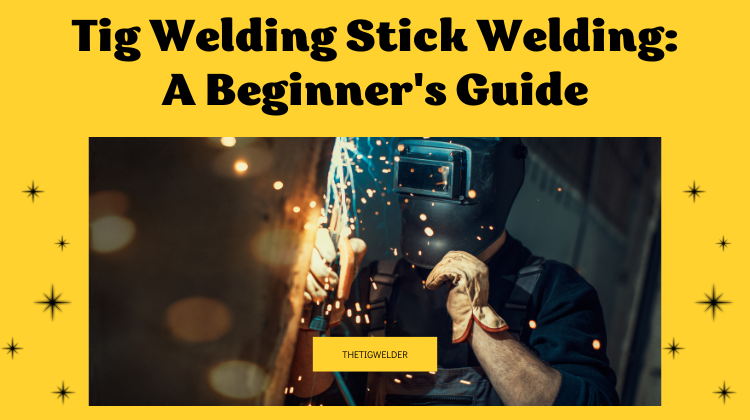Stick welding, also known as shielded metal arc welding (SMAW), is a popular method for welding various metals, including mild steel, stainless steel, and cast iron. It is a relatively easy welding process, making it a good choice for beginners. In this beginner’s guide to stick welding, we will cover the basic principles of the process, including the types of equipment needed and the proper technique for striking an arc.
We will also provide tips for achieving successful stick welds, including proper preparation of the materials, selection of the right filler metal and electrodes, and proper joint preparation. Following these guidelines, even a beginner can produce strong, high-quality welds using stick welding.

Tig Welding Stick Welding
This article will provide a beginner’s guide to tig welding and stick welding, including an overview of the process, safety considerations, and tips for achieving success.
Preparing for Tig Welding and Stick Welding
Before you begin tig welding or stick welding, taking the necessary safety precautions is important. This includes wearing protective gear, such as a welding helmet, gloves, and long sleeves to protect your skin from the arc. It’s also important to work in a well-ventilated area to reduce the risk of inhaling toxic fumes.
In terms of equipment, you’ll need a tig welding machine or stick welding machine, a tungsten electrode (for tig welding), and filler wire or electrodes appropriate for the material you are welding. You’ll also need a gas cylinder and a flowmeter (for tig welding) to regulate shielding gas flow, which helps protect the weld from oxygen and other contaminants.
Before you begin welding, it’s also important to prepare the workpiece. This includes cleaning the joint and ensuring it is properly aligned and secure. Preheating the workpiece can also help to reduce the risk of warping and distortion during the welding process.
Setting Up the Welding Machines
To get the most out of your tig welding or stick welding machine, it’s important to set it up correctly. This includes setting the correct amperage and voltage for the material you are welding and the thickness of the workpiece. For tig welding, you’ll also need to select the correct filler wire and set up the gas flow.
Step-by-Step Guide
Once you have your equipment set up, you’re ready to begin welding. The first step is to clean and prepare the joint. This includes removing any dirt, debris, or contaminants that could affect the quality of the weld.
Next, you’ll need to make the weld pass. Tig welding involves maintaining a steady hand and a consistent arc length and stick welding involves striking an arc and maintaining it as you add filler metal to the joint. It’s also important to keep the tungsten electrode or electrode at the correct angle, typically around 15-20 degrees from the workpiece.
As you make the weld pass, it’s important to maintain a consistent travel speed and to keep the puddle under control. The puddle is the molten pool of filler and base metal that forms during the welding process. Proper puddle control allows you to shape the weld and fill the joint, resulting in a strong, high-quality weld.
After you’ve made the weld pass, you’ll need to finish the weld. This may involve adding a final layer of filler metal for tig welding to create a smooth, even finish. Stick welding may involve chipping away any slag that has formed on top of the weld.
Consider post-weld heat treatment depending on the material you are welding and the strength of the weld that you need. This involves heating the weld area to a specific temperature and holding it at that temperature for a set amount of time. Post-weld heat treatment can help to relieve stress in the weld and improve its overall strength and flexibility.
Common Challenges and Solutions
Tig welding and stick welding can present several challenges, but these can be overcome with the right techniques and equipment. One common challenge is oxidization, which occurs when the material reacts with the air to form a thin layer of oxide on the surface of the metal. This can make it difficult to create a strong, reliable weld. To prevent oxidization, it’s important to use a shielding gas, such as argon, to protect the weld from the air. You can also use a cleaning agent, such as a ceramic wipe, to remove any oxide that does form.
Another challenge in tig welding and stick welding is warping and distortion. This can occur when the weld cools too quickly, causing the metal to contract unevenly. Preheating the workpiece before welding is important to minimize this risk, using a low amperage and a slow travel speed.
Finally, it’s common to encounter weld defects when tig welding or stick welding. These can include porosity, undercut, or incomplete fusion. To minimize the risk of weld defects, it’s important to use the correct filler wire and to maintain a consistent arc length and travel speed. If you encounter defects, they can often be repaired by adding additional filler metal or grinding the defect down and rewelding the area. Following proper repair, techniques are important to ensure that the weld is strong and reliable after the repair.
What Is Stick Welding Best For?
Stick welding, also known as shielded metal arc welding (SMAW), is a manual welding process that is well-suited for a wide range of applications, including welding thick materials, welding in outdoor or windy conditions, and welding dirty or rusty materials. Stick welding is a relatively simple and inexpensive process that is relatively easy to learn and use. It is also a forgiving process that can produce high-quality welds even when the welder is not highly skilled. However, stick welding could be better suited for welding thin materials or producing welds with precise tolerances.
Is Stick Welding The Hardest To Learn?
Stick welding is an easier learning process due to its simplicity and forgiving nature. The process does not require a shielding gas, making it easier to set up and use than TIG welding. Stick welding also produces a more visible arc and weld pool, making it easier for the welder to see what is happening during the process. However, stick welding requires manual dexterity and hand-eye coordination, and it can be challenging to produce high-quality welds consistently without proper training and practice.
How Long Does It Take To Learn To Stick Weld?
The amount of time it takes to learn to stick weld will depend on the individual welder’s aptitude, motivation, and access to training and practice. Some welders may be able to learn the basics of stick welding in just a few hours, while others may require more time and practice to develop the necessary skills. In general, it is recommended that welders receive formal training from a qualified instructor and practice regularly to improve their skills and produce consistent, high-quality welds.
What Are The Disadvantages Of Stick Welding?
Some of the main disadvantages of stick welding include the following:
- Lower productivity: Stick welding is slower than other welding methods, such as MIG or TIG welding, which can lower overall productivity.
- Higher distortion: Stick welding produces more heat input into the material than other welding methods, which can result in more distortion. This can make it difficult to produce precise tolerances or maintain the material’s original shape.
- Greater spatter: Stick welding produces more spatter, or small droplets of molten metal, than other welding methods. This can create additional cleanup work and affect the finished weld’s appearance.
- Limited filler metals: Stick welding is generally limited to the use of flux-coated consumable electrodes, which can limit the range of filler metals available. This can make it difficult to achieve certain mechanical properties or to meet specific design requirements.
Is Tig Welding Hard To Learn?
TIG welding is generally considered more difficult to learn due to the precision and skill required to produce high-quality welds. TIG welding requires using a tungsten electrode, a non-consumable electrode that must be held at a precise distance from the workpiece to produce the arc. The welder must also feed the filler metal manually into the weld pool, which requires good hand-eye coordination and attention to detail. Additionally, TIG welding requires shielding gas to protect the weld pool, which adds an extra layer of complexity to the process. However, with practice and training, TIG welding can be mastered and is a valuable skill in many welding applications.
Conclusion
Tig and stick welding are popular methods for creating strong, durable welds. Following the right techniques and using the right equipment can achieve high-quality welds free of defects. It’s important to take the necessary safety precautions and to practice and seek training to improve your skills. With the right approach, tig welding and stick welding can be valuable additions to your repertoire. Whether working on a DIY project or a professional job, these tips and tricks can help you succeed in tig welding and stick welding.

It’s been years since I got into welding as a side hustle. It’s been so long since Doing All kinds of welds for business and pleasure as this is my hobby. Being in this field I have learned from hands-on-experience also came to know what gears work and what doesn’t. The Tig Welder is my own platform where I use to share my experience.






Leave a Reply